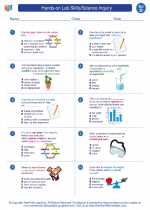Appearance
Appearance refers to the way an object or organism looks to the human eye. In science, appearance can be studied in various ways, including color, texture, shape, and size.
Color
Color is a visual perception that is created in the brain when light is interpreted by the eyes. Different objects and organisms have different colors due to the way they reflect and absorb light. For example, leaves appear green because they contain chlorophyll, which absorbs all colors except green, which is reflected into our eyes.
Texture
Texture refers to the surface quality of an object or organism. It can be described as smooth, rough, bumpy, or any other tactile sensation. For example, a smooth rock has a different texture than a rough piece of bark.
Shape
The shape of an object or organism refers to its physical form or outline. Shapes can be simple, like a circle or square, or more complex, like the shape of a leaf or animal. Understanding the shape of things can help scientists classify and identify different species.
Size
Size refers to the dimensions of an object or organism, such as its height, width, and length. Measuring size is an important aspect of scientific study, as it can provide valuable information about the characteristics and behavior of different objects and organisms.
Study Guide
- What is appearance in science?
- Explain how color is perceived by the human eye.
- Describe the concept of texture and provide examples.
- How does shape contribute to the classification of objects and organisms?
- Why is measuring size important in scientific study?
By understanding and studying appearance, scientists can gain valuable insights into the characteristics and behavior of the natural world. This knowledge can be applied to various fields, including biology, geology, and environmental science.
.◂Science Worksheets and Study Guides Fourth Grade. Hands-on Lab Skills/Science Inquiry

 Worksheet/Answer key
Worksheet/Answer key
 Worksheet/Answer key
Worksheet/Answer key
 Worksheet/Answer key
Worksheet/Answer key
